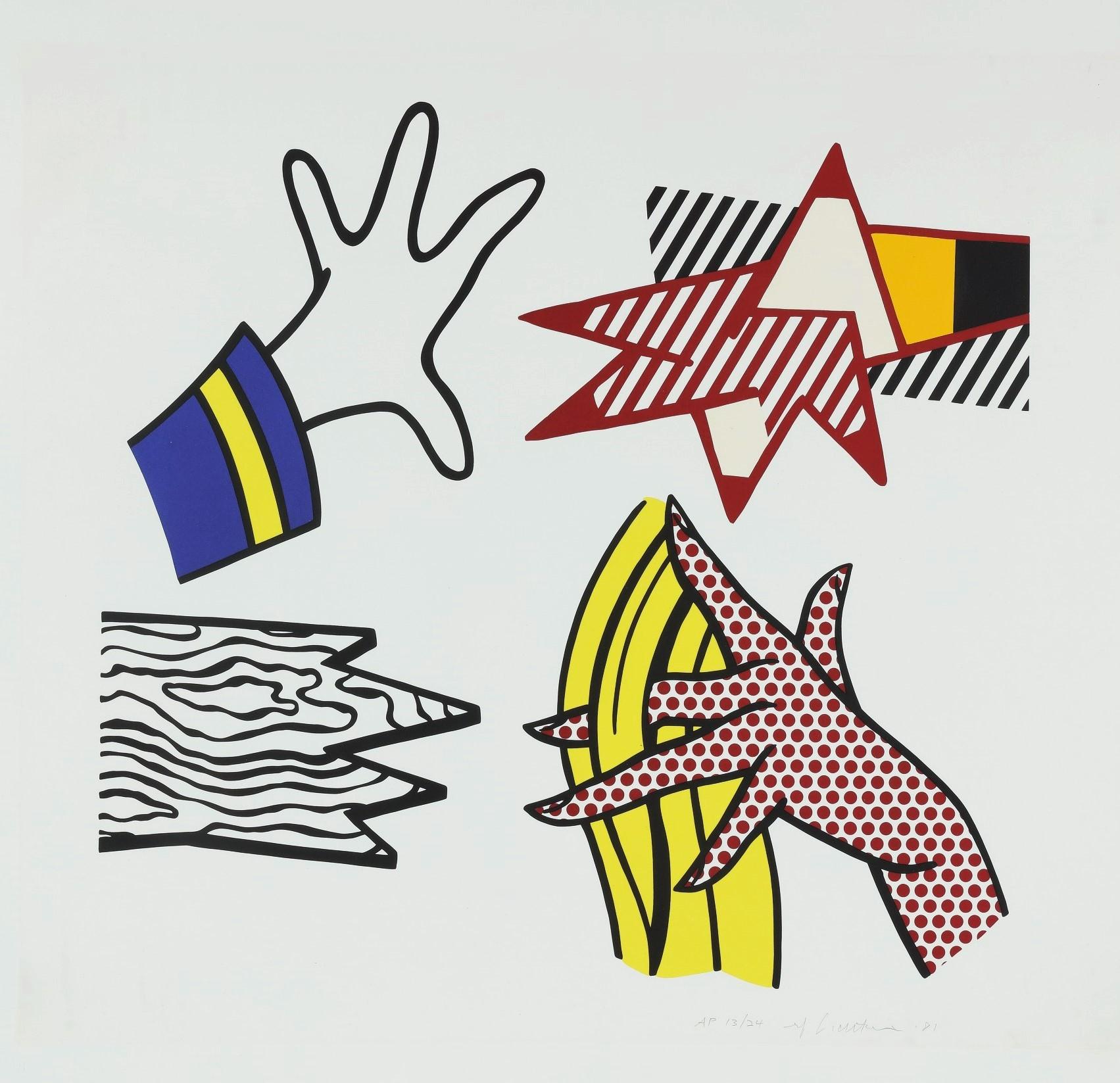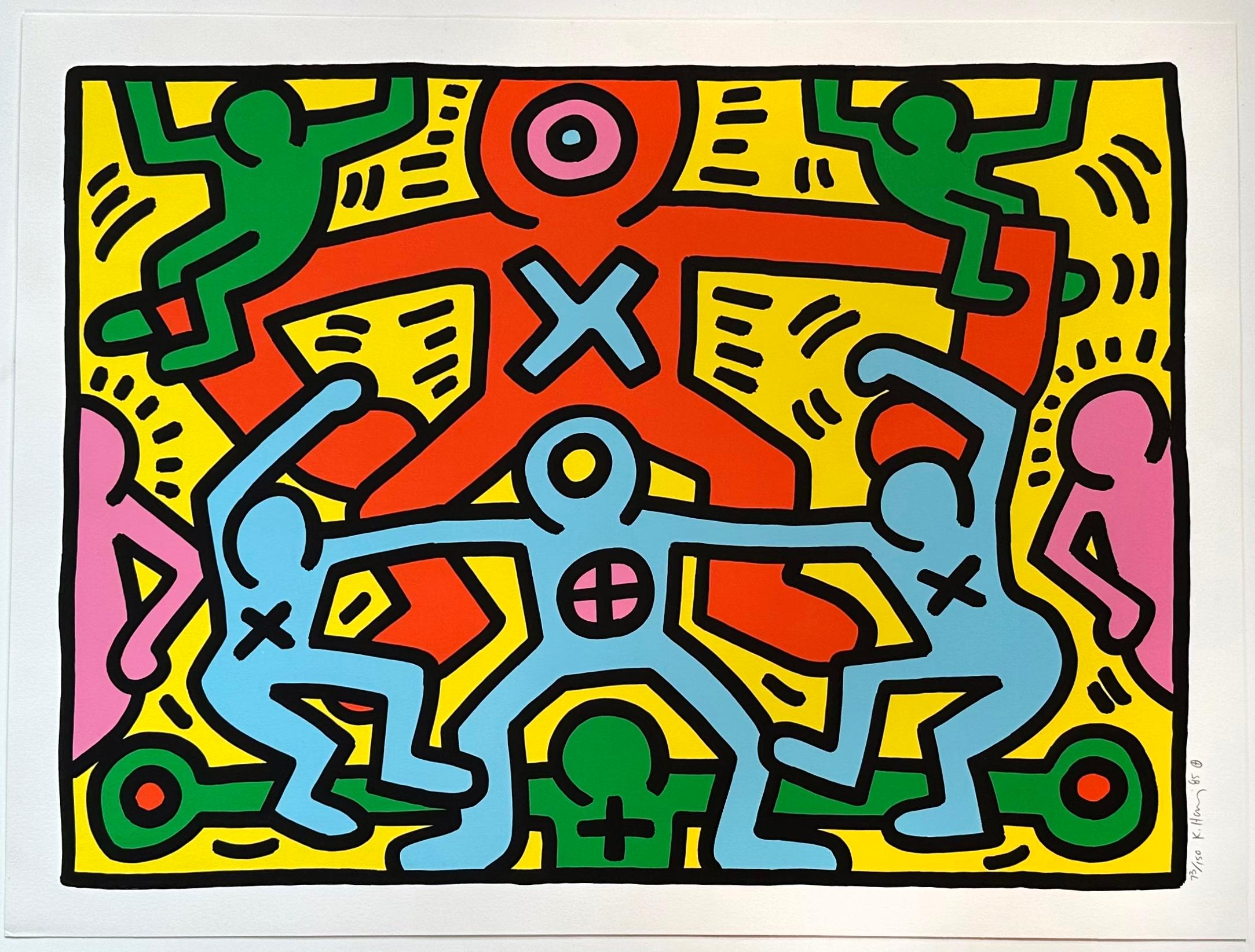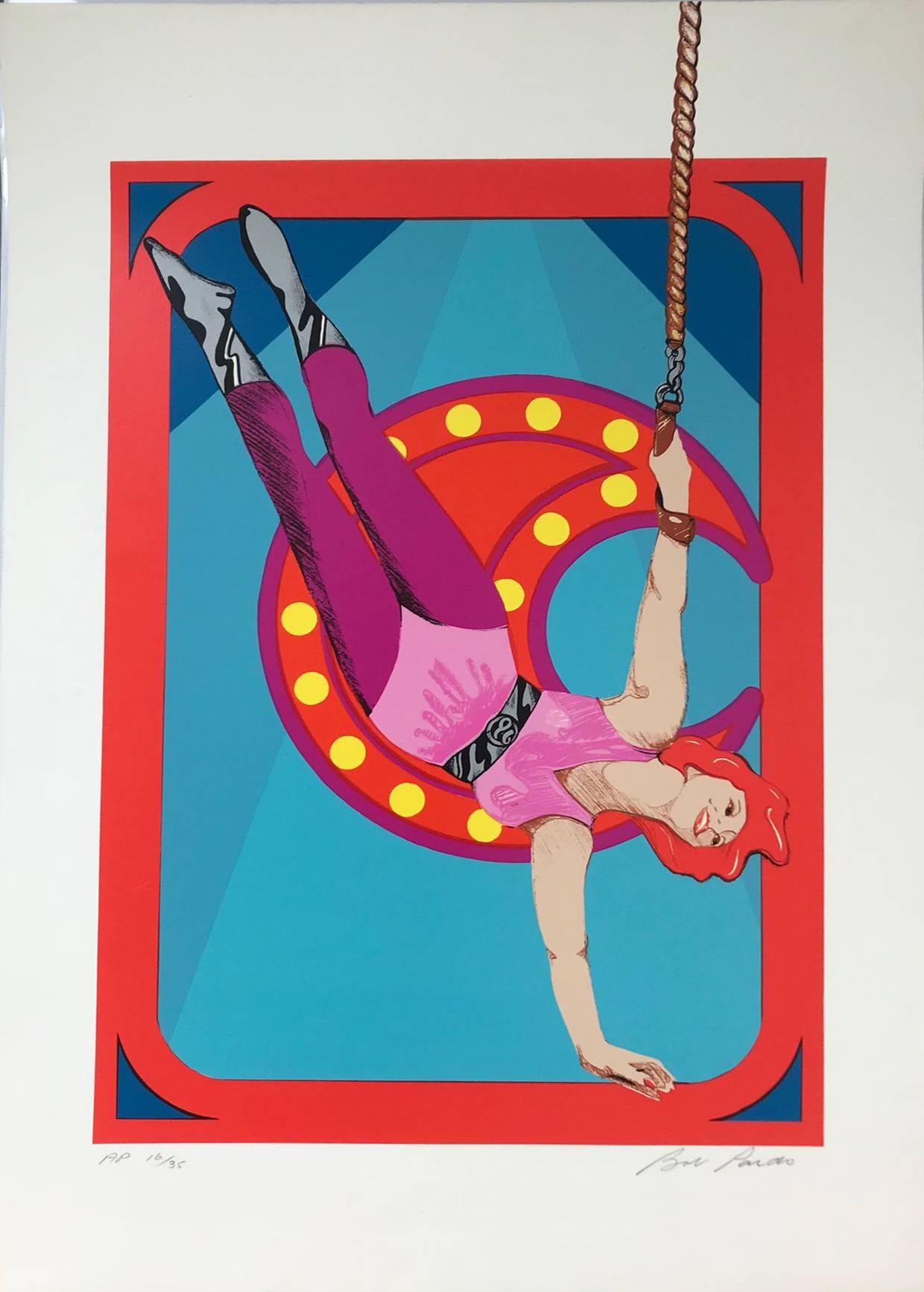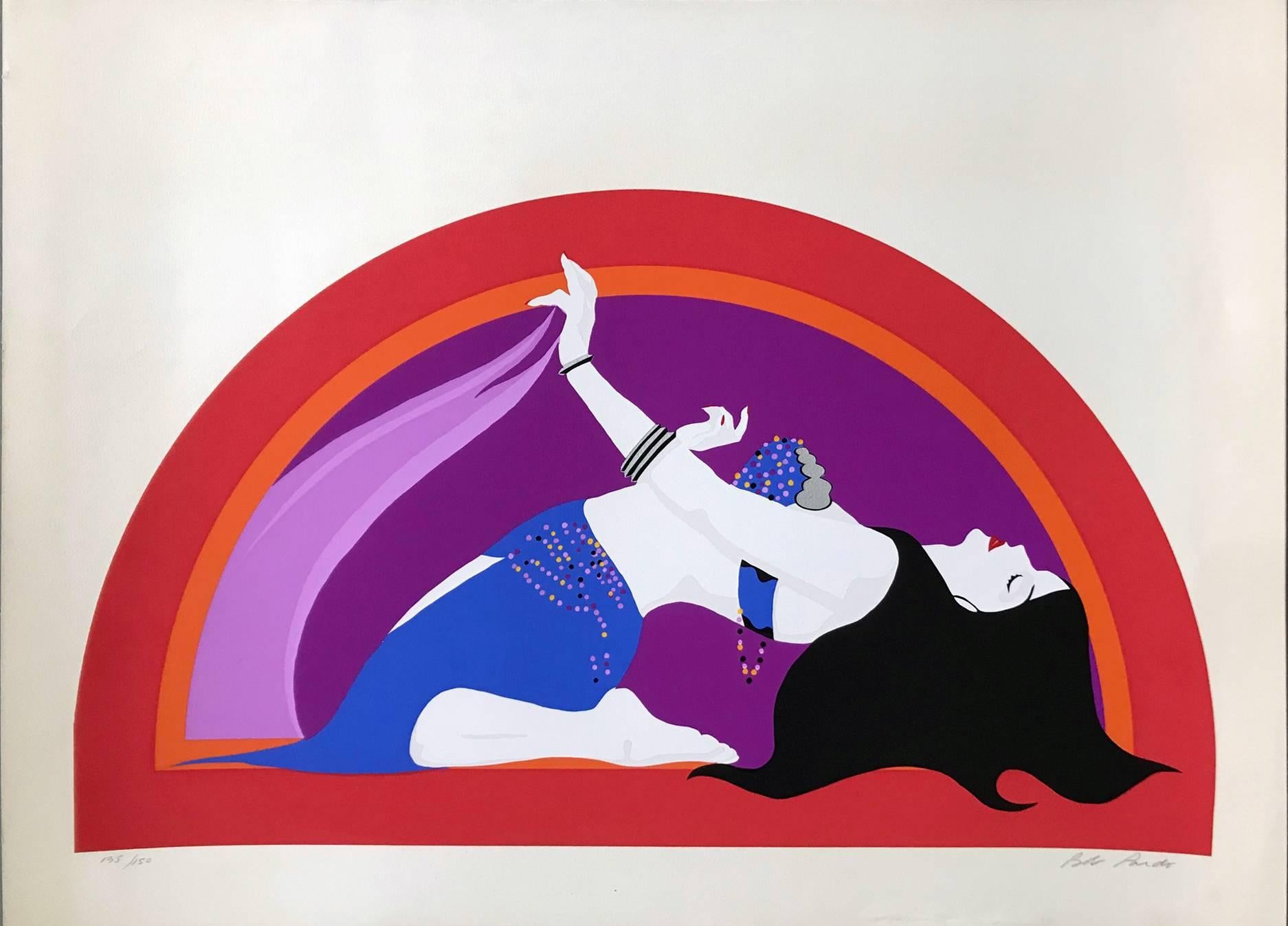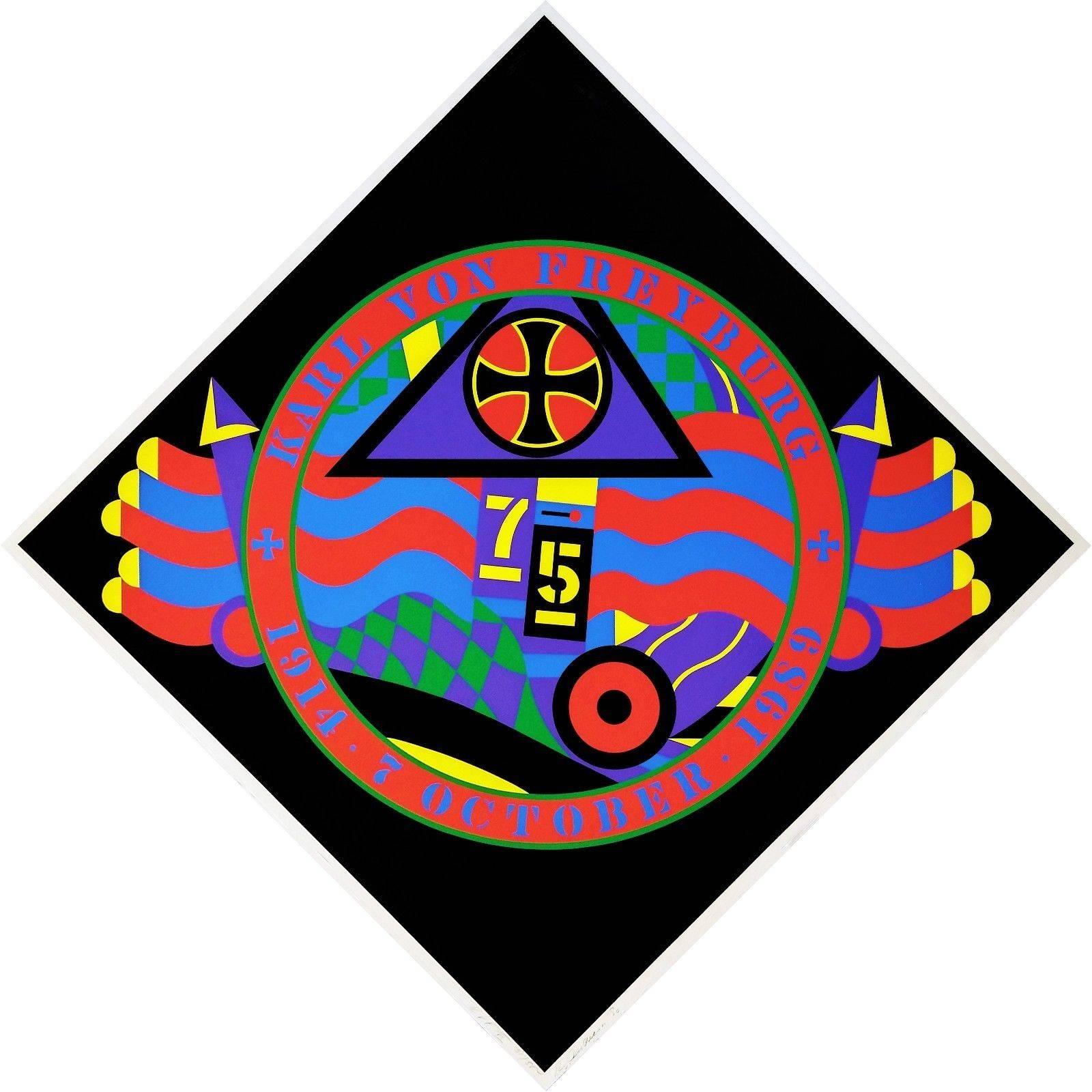Items Similar to Large Pop Art Abstract Figure Digital Barcode Silkscreen Screenprint 80s Memphis
Want more images or videos?
Request additional images or videos from the seller
1 of 12
David PrenticeLarge Pop Art Abstract Figure Digital Barcode Silkscreen Screenprint 80s Memphis1981
1981
About the Item
I was told this might be by another David Prentice. as I am uncertain I will add his bio. I cannot ascertain which one it is.
Vintage 1981 DAVID PRENTICE ABSTRACT POP ART SERIGRAPH PRINT
Very large Lithograph serigraph on BFK Rives art paper, dated 1981, signed and numbered. It has light wear in the margins but in overall good condition.
David R. Prentice (born December 22, 1943) is an American artist.
Prentice was born in Hartford, Connecticut and studied at the Art School of the University of Hartford from 1962 to 1964, after which he worked for multiple esteemed artists including Jasper Johns, Robert Rauschenberg, Andy Warhol, Robert Motherwell, Helen Frankenthaler, Alexander Liberman and Malcolm Morley.
Prentice is an accomplished and internationally known landscape painter. He has exhibited his work in the United States and Japan. During the 1960s Prentice was associated with Lyrical Abstraction and his work was exhibited at the Park Place Gallery in New York City among other places.
David Prentice (4 July 1936 - 7 May 2014) was a British artist and former art teacher. In 1964 he was one of the four founding members of Birmingham's Ikon Gallery. Prentice's work features in the collections of the Victoria and Albert Museum in London, Birmingham Museum and Art Gallery, the Art Institute of Chicago, the Albright-Knox Art Gallery in Buffalo, New York and the Museum of
Modern Art in New York City, Ashmolean Oxford, Bass Museum Miami, House of Commons Acquisition Committee Westminster, Betty Parsons New York, The Rank Organisation, Miami Dade Community College Miami, Arts Council of Great Britain and many private collections. He is four times winner of the Sunday Times Watercolour Competition - First Prize 1990, Second Prize 1999 and third prizes in 1996 and 2007. He was married to the quilt artist Dinah Prentice and since 1990 had lived and worked in Malvern, Worcestershire. Prentice was born in Solihull and educated at Moseley Road Secondary School of Art, Birmingham between 1949 and 1952, and Birmingham School of Art between 1952 and 1957. In 1957 he did National Service in the Royal Artillery, returning to the Birmingham School of Art to teach from 1959. Prentice taught at the Faculty of Birmingham Polytechnic between 1971 and 1986, initially in charge the experimental workshop, and has been a visiting artist at Trent Polytechnic, Nottingham University, the Ruskin School and the Birmingham Institute of Art and Design. - Prentice held solo exhibitions at the Royal Birmingham Society of Artists in 1961 and 1963, and in the same year as the second featured in the Four Letter Art exhibition organised by Trevor Denning. Prentice has since held over forty solo exhibitions. It was at Prentice's 1963 solo exhibition that his painting Kate and the Waterlilies was bought by Angus Skene for £25, with Prentice delivering the painting to Skene's house in Selly Oak strapped to the side of his Vespa scooter. Over the subsequent meal the two discussed the lack of support provided to local artists by Birmingham's existing galleries, and decided to start a new organisation to "invigorate the city with progressive ideas about art". Prentice recruited three fellow artists from the School of Art - Jesse Bruton, Robert Groves and Sylvania Merilion - and in 1965 the four established the Ikon Gallery in a kiosk in Birmingham's Bullring. Prentice later said of Ikon's founders: "The stances of the original artists were all very different. Sometimes we were going in opposite directions, but we were all Brummies. We had all come out of the art school thinking 'we can do better than this' ... there was an element of wanting to shift the ground we all shared.
David Prentice had shown his work at John Davies Fine Art, Moreton in Marsh Glos. England in eight solo exhibitions up until 2010 since 1996. He had held solo exhibitions of his work at Mark Barrow Fine Art, Art First London, Anna Mei Chadwick London, Medici Gallery London and Lemon Street Gallery Truro Cornwall in the years following 1994 and up to 2008. Exhibitions during July and August 2011 to celebrate his 75th birthday were at John Davies Gallery Moreton in Marsh, Number Nine the Gallery Birmingham and at Monnow Art Centre, Walterstone, Herefordshire.
- Creator:David Prentice (1936 - 2014, British)
- Creation Year:1981
- Dimensions:Height: 58 in (147.32 cm)Width: 32 in (81.28 cm)
- Medium:
- Movement & Style:
- Period:
- Condition:minor wear to edges in margins, minor age toning. please see photos.
- Gallery Location:Surfside, FL
- Reference Number:1stDibs: LU38213963722
About the Seller
4.9
Platinum Seller
These expertly vetted sellers are 1stDibs' most experienced sellers and are rated highest by our customers.
Established in 1995
1stDibs seller since 2014
1,556 sales on 1stDibs
Typical response time: 1 hour
- ShippingRetrieving quote...Ships From: Surfside, FL
- Return PolicyA return for this item may be initiated within 3 days of delivery.
More From This SellerView All
- Joe Tilson British Pop Art Screenprint, Woodblock, Gold Leaf PrintBy Joe TilsonLocated in Surfside, FLSilkscreen screenprint with woodblock and gold leaf Hand signed and numbered. Joseph Charles Tilson RA (born 24 August 1928 in London) is an English pop art painter, sculptor and pr...Category
1990s Pop Art Abstract Prints
MaterialsScreen
- Vibrant Joe Tilson British Pop Art Screenprint, Woodblock, Colorful PrintBy Joe TilsonLocated in Surfside, FLSilkscreen screenprint with woodblock and silver leaf Hand signed and numbered. In vibrant color of blue and silver on heavy paper with an almost painting type texture to it. Josep...Category
1990s Pop Art Abstract Prints
MaterialsScreen
- Joe Tilson British Pop Art Screenprint, Color Lithograph 4 Seasons 4 ElementsBy Joe TilsonLocated in Surfside, FLSilkscreen screenprint or Lithograph Hand signed and numbered. An esoteric, mystical, Kabbala inspired print with Hebrew as well as other languages. Joseph Charles Tilson RA (born 2...Category
1970s Pop Art Abstract Prints
MaterialsLithograph, Screen
- Vibrant 1975 Joe Tilson British Pop Art Screenprint, Woodblock, Colorful PrintBy Joe TilsonLocated in Surfside, FLSilkscreen screenprint. Hand signed and numbered. A pyramid or ziggurat in vibrant colors of blue, red, yellow, orange and green on heavy paper Joseph Charles Tilson RA (born 24 Au...Category
1970s Pop Art Abstract Prints
MaterialsScreen
- Deborah Kass Feminist Jewish American Pop Art Silkscreen Screenprint Ltd EditionBy Deborah KassLocated in Surfside, FLDeborah Kass (born 1952) Limited edition geometric abstract lithograph in colors on artist paper. Hand signed and dated in pencil to lower right. 1973. Edition: 102/120 to lower left. Dimensions: sight: 16-3/4" W x 21-1/4" H. Frame: 24-5/8" W x 28-7/8" H. Finding inspiration in pop culture, political realities, film, Yiddish, art historical styles, and prominent art world figures, Deborah Kass uses appropriation in her work to explore notions of identity, politics, and her own cultural interests. She received her BFA in painting at Carnegie Mellon University and studied at the Whitney Museum Independent Study Program and the Art Students League of New York. Deborah Kass (born 1952) is an American artist whose work explores the intersection of pop culture, art history, and the construction of self. Deborah Kass works in mixed media, and is most recognized for her paintings, prints, photography, sculptures and neon lighting installations. Kass's early work mimics and reworks signature styles of iconic male artists of the 20th century including Frank Stella, Andy Warhol, Jackson Pollock, and Ed Ruscha. Kass's technique of appropriation is a critical commentary on the intersection of social power relations, identity politics, and the historically dominant position of male artists in the art world. Deborah Kass was born in 1952 in San Antonio, Texas. Her grandparents were from Belarus and Ukraine, first generation Jewish immigrants to New York. Kass's parents were from the Bronx and Queens, New York. Her father did two years in the U.S. Air Force on base in San Antonio until the family returned to the suburbs of Long Island, New York, where Kass grew up. Kass’s mother was a substitute teacher at the Rockville Centre public schools and her father was a dentist and amateur jazz musician. At age 14, Kass began taking drawing classes at The Art Students League in New York City which she funded with money she made babysitting. In the afternoons, she would go to theater on and off Broadway, often sneaking for the second act. During her high school years, she would take her time in the city to visit the Museum of Modern Art, where she would be exposed to the works of post-war artists like Frank Stella and Willem De Kooning. At age 17, Stella’s retrospective exhibition inspired Kass to become an artist as she observed and understood the logic in his progression of works and the motivation behind his creative decisions. Kass received her BFA in Painting at Carnegie Mellon University (the alma mater of artist Andy Warhol), and studied at the Whitney Museum Independent Study Program Here, she created her first work of appropriation, Ophelia’s Death After Delacroix, a six by eight foot rendition of a small sketch by the French Romantic artist, Eugène Delacroix. At the same time Neo-Expressionism was being helmed by white men in the late Reagan years, women were just beginning to create a stake in the game for critical works. “The Photo Girls...Category
2010s Pop Art Figurative Prints
MaterialsScreen
- Deborah Kass Feminist Jewish American Pop Art Silkscreen Screenprint Ltd EditionBy Deborah KassLocated in Surfside, FLDeborah Kass (born 1952) Being Alive, 2012 nine-color silkscreen, one color blend on 2-ply museum board Image 24 x 24 image. Frame 29 x 29 x 2 inches Edition 1/65 Hand signed and dated in pencil, lower right verso; numbered lower left verso Being Alive is from a vibrant and uplifting body of work entitled Feel Good Paintings for Feel Bad Times. Finding inspiration in pop culture, political realities, film, Yiddish, art historical styles, and prominent art world figures, Deborah Kass uses appropriation in her work to explore notions of identity, politics, and her own cultural interests. She received her BFA in painting at Carnegie Mellon University and studied at the Whitney Museum Independent Study Program and the Art Students League of New York. Deborah Kass (born 1952) is an American artist whose work explores the intersection of pop culture, art history, and the construction of self. Deborah Kass works in mixed media, and is most recognized for her paintings, prints, photography, sculptures and neon lighting installations. Kass's early work mimics and reworks signature styles of iconic male artists of the 20th century including Frank Stella, Andy Warhol, Jackson Pollock, and Ed Ruscha. Kass's technique of appropriation is a critical commentary on the intersection of social power relations, identity politics, and the historically dominant position of male artists in the art world. Deborah Kass was born in 1952 in San Antonio, Texas. Her grandparents were from Belarus and Ukraine, first generation Jewish immigrants to New York. Kass's parents were from the Bronx and Queens, New York. Her father did two years in the U.S. Air Force on base in San Antonio until the family returned to the suburbs of Long Island, New York, where Kass grew up. Kass’s mother was a substitute teacher at the Rockville Centre public schools and her father was a dentist and amateur jazz musician. At age 14, Kass began taking drawing classes at The Art Students League in New York City which she funded with money she made babysitting. In the afternoons, she would go to theater on and off Broadway, often sneaking for the second act. During her high school years, she would take her time in the city to visit the Museum of Modern Art, where she would be exposed to the works of post-war artists like Frank Stella and Willem De Kooning. At age 17, Stella’s retrospective exhibition inspired Kass to become an artist as she observed and understood the logic in his progression of works and the motivation behind his creative decisions. Kass received her BFA in Painting at Carnegie Mellon University (the alma mater of artist Andy Warhol), and studied at the Whitney Museum Independent Study Program Here, she created her first work of appropriation, Ophelia’s Death After Delacroix, a six by eight foot rendition of a small sketch by the French Romantic artist, Eugène Delacroix. At the same time Neo-Expressionism was being helmed by white men in the late Reagan years, women were just beginning to create a stake in the game for critical works. “The Photo Girls” consisted of artists like Sherrie Levine, Cindy Sherman, and Barbara Kruger. Kass felt that content of these works connected those of the post-war abstract painters of the mid-70s including Elizabeth Murray, Pat Steir, and Susan Rothenberg. All of these artists critically explored art in terms of new subjectivities from their points-of-view as women. Kass took from these artists the ideas of cultural and media critique, inspiring her Art History Paintings. Kass is most famous for her “Decade of Warhol,” in which she appropriated various works by the pop artist, Andy Warhol. She used Warhol’s visual language to comment on the absence of women in art history at the same time that Women’s Studies began to emerge in academia. Reading texts on subjectivity, objectivity, specificity, and gender fluidity by theorists like Judith Butler and Eve Sedgwick, Kass became literate in ideas surrounding identity. She engaged with art history through the lens of feminism, because of this theory which “The Photo Girls” drew upon. Kass's work is in the collections of the Museum of Modern Art; Whitney Museum of American Art; Solomon R. Guggenheim Museum; Jewish Museum (New York); Museum of Fine Art, Boston; Cincinnati Museum of Art; New Orleans Museum; National Portrait Gallery, Smithsonian Institution; Fogg Museum, Harvard Art Museums; and Weatherspoon Museum, among others. In 2012 Kass's work was the subject of a mid-career retrospective Deborah Kass, Before and Happily Ever After at The Andy Warhol Museum in Pittsburgh, PA. An accompanying catalogue published by Skira Rizzoli, included essays by noted art historians Griselda Pollock, Irving Sandler, Robert Storr, Eric C. Shiner and writers and filmmakers Lisa Liebmann, Brooks Adams, and John Waters. Kass's work has been shown at international private and public venues including at the Venice Biennale, the Istanbul Biennale, the Museum Ludwig, Cologne, the Museum of Modern Art, The Jewish Museum, New York, the National Portrait Gallery, and the Museum of Fine Arts, Boston. A survey show, Deborah Kass, The Warhol Project traveled across the country from 1999–2001. She is a Senior Critic in the Yale University M.F.A. Painting Program. Kass's later paintings often borrow their titles from song lyrics. Her series feel good paintings for feel bad times, incorporates lyrics borrowed from The Great American Songbook, which address history, power, and gender relations that resonate with Kass's themes in her own work. In Kass's first significant body of work, the Art History Paintings, she combined frames lifted from Disney cartoons with slices of painting from Pablo Picasso, Jasper Johns, Jackson Pollock, and other contemporary sources. Establishing appropriation as her primary mode of working, these early paintings also introduced many of the central concerns of her work to the present. Before and Happily Ever After, for example, coupled Andy Warhol’s painting of an advertisement for a nose job with a movie still of Cinderella fitting her foot into her glass slipper, touching on notions of Americanism and identity in popular culture. The Art History Paintings series engages critically with the history of politics and art making, especially exploring the power relationship of men and women in society. Deborah Kass's work reveals a personal relationship she shares with particular artworks, songs and personalities, many of which are referenced directly in her paintings. In 1992, Kass began The Warhol Project. Beginning in the 1960s, Andy Warhol’s paintings employed mass production through screen-printing to depict iconic American products and celebrities. Using Warhol’s stylistic language to represent significant women in art, Kass turned Warhol’s relationship to popular culture on its head by replacing them with subjects of her own cultural interests. She painted artists and art historians that were her heroes including Cindy Sherman, Elizabeth Murray, and Linda Nochlin. Drawing upon her childhood nostalgia, the Jewish Jackie series depicts actress Barbra Streisand, a celebrity with whom she closely identifies, replacing Warhol's prints of Jackie Kennedy Onassis and Marilyn Monroe. Her My Elvis series likewise speaks to gender and ethnic identity by replacing Warhol's Elvis with Barbra Streisand from Yentl: a 1983 film in which Streisand plays a Jewish woman who dresses and lives as a man in order to receive an education in the Talmudic Law. Kass's Self Portraits as Warhol further deteriorates the idea of rigid gender norms and increasingly identifies the artist with Warhol. By appropriating Andy Warhol's print Triple Elvis and replacing Elvis Presley with Barbara Streisand’s Yentl, Kass is able to identify herself with history’s icons, creating a history with powerful women as subjects of art. The work embodies her concerns surrounding gender representation, advocates for a feminist revision of art, and directly challenges the tradition of patriarchy. America's Most Wanted is a series of enlarged black-and-white screen prints of fake police mug shots. The collection of prints from 1998–1999 is a late-1990s update of Andy Warhol’s 1964 work 13 Most Wanted Men, which featured the most wanted criminals of 1962. The “criminals” are identified in titles only by first name and surname initial, but in reality the criminals depicted are individuals prominent in today's art world. Some of the individuals depicted include Donna De Salvo, deputy director for international initiatives and senior curator at the Whitney Museum of American Art; Thelma Golden, director and chief curator of the Studio Museum in Harlem, and Robert Storr, dean of the Yale School of Art. Kass's subjects weren’t criminals. Through this interpretation, Kass show's how they are wanted by aspirants for their ability to elevate artists’ careers. The series explores the themes of authorship and the gaze, at the same time problematizing certain connotations within the art world. In 2002, Kass began a new body of work, feel good paintings for feel bad times, inspired, in part, by her reaction to the Bush administration. These works combine stylistic devices from a wide variety of post-war painting, including Ellsworth Kelly, Frank Stella, Jackson Pollock, Andy Warhol, and Ed Ruscha, along with lyrics by Stephen Sondheim, Laura Nyro, and Sylvester, among others, pulling from popular music, Broadway show tunes, the Great American Songbook, Yiddish, and film. The paintings view American art and culture of the last century through the lens of that time period's outpouring of creativity that was the result of post-war optimism, a burgeoning middle class, and democratic values. Responding to the uncertain political and ecological climate of the new century in which they have been made, Kass's work looks back on the 20th century critically and simultaneously with great nostalgia, throwing the present into high relief. Drawing, as always, from the divergent realms of art history, popular culture, political realities, and her own political and philosophical reflection, the artist continues into the present the explorations that have characterized her paintings since the 1980s in these new hybrid textual and visual works. OY/YO In 2015, Two Tree Management Art in Dumbo commissioned of a monumentally scaled installation of OY/YO for the Brooklyn Bridge Park. The sculpture, measuring 8×17×5 ft., consists of big yellow aluminum letters, was installed on the waterfront and was visible from the Manhattan. It spells “YO” against the backdrop of Brooklyn. The flip side, for those gazing at Manhattan, reads “OY.”[ An article and photo appeared on the front page of the New York Times 3 days after its installation in the park. An instant icon, OY/YO stayed at that site for 10 months where it became a tourist destination, a favorite spot for wedding, graduation, class photos and countless selfies. After its stay in Dumbo it moved to the ferry stop at North 6th Street in Williamsburg, Brooklyn for a year, where it greeted ferry riders. Since 2011, OY/YO has been a reoccurring motif in Deborah Kass's work in the form of paintings, prints, and tabletop sculptures. Kass first created “OY” as a painting riffing on Edward Ruscha’s 1962 Pop canvas, “OOF.” She later painted “YO” as a diptych that nodded to Picasso's 1901 self-portrait, “Yo Picasso” (“I, Picasso”). OY/YO is now installed in front of the Brooklyn Museum. Another arrived at Stanford University in front of the Cantor Arts Center late 2019. A large edition of OY/YO was acquired by the Jewish Museum in New York in 2017 and is on view in the exhibition Scenes from the Collection. On December 9, 2015 Deborah Kass introduced her new paintings that incorporated neon lights in an exhibition at Paul Kasmin Gallery entitled "No Kidding" in Chelsea, New York. The exhibition was an extension of her Feel Good Paintings for Feel Bad Times, but it sets a darker, tougher tone as she reflects on contemporary issues such as global warming, institutional racism, political brutality, gun violence, and attacks on women's health, through the lens of minimalism and grief. The series is ongoing. Deborah Kass has spoken about creating an “ode to the great Louises,” a space dedicated to her works inspired by famous Louise’s which she would call the “Louise Suite.” The earliest of these odes is “Sing Out Louise,” a 2002 oil on linen painting from her Feel Good Paintings Feel Bad Times collection. “Sing out Louise” is driven by her fondness for Rosalind Russel and the fact Kass feels it is her time to “Sing Out] “After Louise Bourgeois” is a 2010 sculpture made of neon and transformers on powder-coated aluminum monolith; it is a spiraling neon light with a phrase inspired by French-American artist Louise Bourgeois.[22] The neon installation reads “A woman has no place in the art world unless she proves over and over again that she won’t be eliminated.” Kass changed the quote slightly to better represent her beliefs but it was derived from Bourgeois. “After Louise Nevelson” is a 2020 spiraling neon work of art that reads "Anger? I'd be dead without my anger" a quote from American sculptor, Louise Nevelson. Award and Grants New York Foundation for the Arts, inducted into NYFA Hall of Fame (2014) Art Matters Inc. Grant (1996) Art Matters Inc. Grant (1992) New York Foundation for the Arts, Fellowship in Painting 1987 National Endowment for the Arts, Painting (1991) National Endowment For The Arts (1987) Selected solo and group exhibitions The Jewish Museum, New York, NY, “Scenes from the Collection” National Portrait Gallery, Washington, DC “Eye Pop: the Celebrity Gaze” Paul Kasmin Gallery, New York, NY, “No Kidding” (2015-2016) Sargent...Category
2010s Pop Art Figurative Prints
MaterialsScreen
You May Also Like
- Study of HandsBy Roy LichtensteinLocated in New York, NYCreated in 1981 as an original lithograph with screen-printing, Roy Lichtenstein’s, Study of Hands is hand-signed in pencil, dated and numbered, measuring 31 ¼ x 32 ¾ in. (79.5 x 83....Category
20th Century Pop Art Figurative Prints
MaterialsLithograph, Screen
- UntitledBy Keith HaringLocated in New York, NYCreated by Keith Haring in 1985 as an original screenprint in colors, Untitled, 1985 is hand-signed, dated and numbered in pencil, measuring 23 ½ x 31 ½ in. (60 x 80 cm), unframed, f...Category
20th Century Pop Art Abstract Prints
MaterialsScreen
- UntitledBy Bob PardoLocated in New York, NYBob Pardo (American), "Untitled", Abstract Screen Print Serigraph, 34 x 23, Late 20th Century Colors: Red, Blue, Yellow, PurpleCategory
Late 20th Century Pop Art Abstract Prints
MaterialsScreen
- Belly Dancer II (Edition 135/150)By Bob PardoLocated in New York, NYArtist: Bob Pardo Title: Belly Dancer II Year: circa 1980 Medium: Serigraph, signed and numbered in pencil Edition: 131/150 Size: 22 x 29.5 inches [55.88 x...Category
1980s Pop Art Abstract Prints
MaterialsScreen
- Untitled ( Artist Proof )By Bob PardoLocated in New York, NYBob Pardo, "Untitled" Artist Proof, Abstract/ Pop Serigraph Screen Print signed and numbered in pencil, 31.50 x 25, Late 20th Century Colors: Purple, R...Category
Late 20th Century Pop Art Abstract Prints
MaterialsScreen
- THE HARTLEY ELEGIES - KvF VIBy Robert IndianaLocated in Aventura, FLHand signed, dated and numbered by the artist. Screenprint on Saunders watercolor paper from the edition of 50. Artwork is in excellent condition. Certificate of authenticity inclu...Category
1990s Pop Art Figurative Prints
MaterialsPaper, Screen
